Public enterprise working for the happiness of all through tourism, JTO
Jeju
HOME > Jeju > Food, Lodging and Clothing
Food, Lodging and Clothing
-

-
Jeju Island has a unique culture of food, clothing, and housing due to the geographic characteristics of the island and its unusual natural environment. Even today, citizens of Jeju Island maintain this unique, traditional flavor reflecting the island’s nature in their houses, tools, and clothing.
- Clothes Food House
- Food
-
-
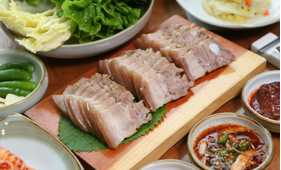
-
Black Pork
Many tourists, on the first time on Jeju, wonder where the best place is to try the island’s delicious black pork. Sometimes, if you go by travel book recommendation it feels that something is missing and if you go to a totally unknown restaurant, you cannot be assured of the taste. In this situation, if you want a clear reply, the answer would be to “just go anywhere.” Wherever you go on Jeju, you can find delicious black pork restaurants. The meat is even more delicious if you eat it with Mel-jeot, which is a salted anchovy that reduces the pork’s oiliness and makes it tastier.
-
-
-
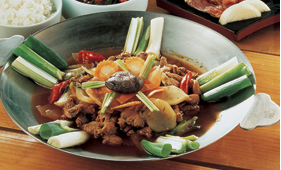
-
Pheasant Cuisine
Since there are many pheasants on Jeju Island, there are many different dishes made using the bird. In the fall, pheasant is regarded as a real treat and can be eaten raw or dried as jerky. Kkwong-toryeom is a delicacy of thinly sliced pheasant breast meat that is eaten hot-pot style. Kkwong-memil guksu, (pheasant buckwheat noodles) delicately blends Jeju’s buckwheat and pheasant meat. The buckwheat noodles are light and more digestible than other foods made with wheat. Pheasant dumpling soup is not greasy and its taste is sure to please.
-
-
-
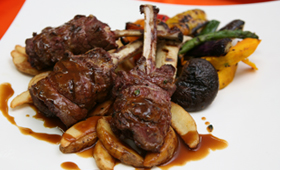
-
Horse Cuisine
Dishes made using horse were the finest served to the King in times of antiquity. Horse is used in a variety of dishes, including raw horse meat, horse sushi, tangsuyuk (sweet and sour meat), galbijjim (rib stew), gui (roast meat) and bulgogi (sliced and seasoned barbequed meat). Horse meat tastes lighter than beef and each part and organ, such as the liver, has its own unique flavor.
-
-
-
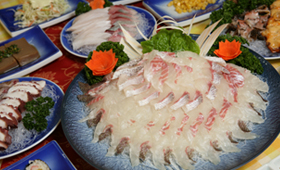
-
Dom-hoe
The most abundant fish on Jeju is the hwang-dom. It is cheap and has an excellent taste but is hard to find on the mainland so don’t miss it while you are on Jeju. If you are looking for a fancier raw fish choice, gat-dom, also known as dol-dom, is also available.
-
-
-
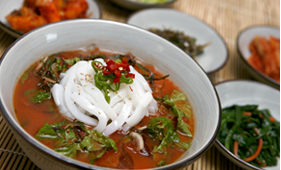
-
Mul-hoe (Water Raw Fish)
A favorite delicacy of summer on Jeju is mul-hoe. It is called mul-hoe as it is prepared by pouring water and spices over fresh raw fish. There are many varieties such as jari-mul-hoe, sea cucumber mul-hoe, turban shell mul-hoe and mitra squid mul-hoe. All the ingredients are fresh so just pick the one that you like best. To prepare, cut vegetables such as parsley, pears, cucumbers, sesame leaves, green pepper and carrots into thin slices, season them with spiced seafood and pour water with ice over them all. The role of the ice is to make the soup cold and keep the seafood and vegetables fresh. After eating all the seafood, adding rice to the leftover soup makes another delicacy.
-
-
-

-
Galchi (hairtail) Cuisine
How best to eat Jeju’s chubby and tasty galchi? The first choice is to eat it fresh as hoe (raw fish). Some people think that galchi-hoe has a fishy smell, but that is not true. It is tasty to chew and famous for its aroma. Another delight is boiled galchi in soy sauce and this is also liked by many. It is delicious if you melt raw galchi in your mouth slowly along with rice, or eat boiled galchi spiced with hot Jeju chili powder.
-
-
-
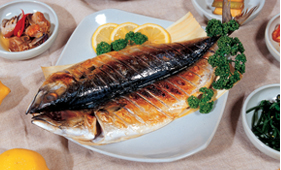
-
Godeungeo (Mackerel)
Godeungeo, along with galchi, is one of the most loved fish types in the country. The full- fleshed fish makes your mouth water in anticipation. Godeungeo is inexpensive, full of nutrients and has an especially aromatic taste. After the breeding season finishes in summer, the fish gains more flesh and oil, thus autumn is the best time to eat it.
-
-
-
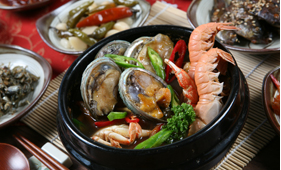
-
Obunjagi Ttukbaegi (Seafood Soup)
The best seafood delight on Jeju Island is Obunjagi Seafood Soup. Obunjagi is a mollusk and a close relative of the abalone family. It lives clinging to rocks about 20 meters under the water. Around 70 percent of the total obunjagi found in Korea is from Jeju. The meat is full of calcium, iron and vitamin B. It can be roasted or put in doenjang soup or porridge, but the most highly recommended option is Obunjagi Seafood Soup. If you make rice using obunjagi, the rice will turn greenish. If you put butter at the edges of an earthen pot and add rice, the butter mixes with the rice making it more aromatic. If you include obunjagi with other seafood in doenjang soup, the taste will double. After eating, you can take the shells home for interior decorations.
-
-
-
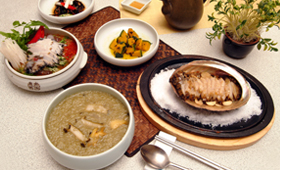
-
Jeon-bok (Abalone)
Jeon-bok (abalone) is so nutritious that it is also known as the wild ginseng of the sea. Many abalones are gathered from Jeju waters and it can be found in many delicacies. It is usually added to jeon-bok-hoe, juk (porridge), ttukbaegi, samgyetang (chicken soup with ginseng), and various other stews. Due to its quality and taste, abalone was offered to kings in olden times. Chajeon-bok is readily available on Jeju, as is obunjagi, which is another kind of Jeon-bok.
-
-
-

-
Sora (Turban shell)
Another common delicacy in seafood-rich Jeju is the sora (turban shell or conch). Therefore Jeju’s sora is also known as the Tangerine of the Sea. Small hwalsora, which are also known as Gujeng- ki in Jeju, are hard and firm and the texture is like chewing Jeon-bok. Broiled sora roasted with its shell, sora-mul-hoe, jeot-kal and porridge made of sora are full of nutrients. The most common way to eat sora is to simply rinse it with sea water, cut it into thin slices and eat it with red chili-pepper paste and vinegar.
-
-
-
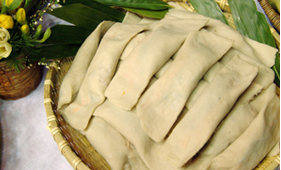
-
Bingddeok (Bing rice cake)
Bingddeok is named after the shape of the ddeok after it is rolled. Fine buckwheat powder is made into a dough, which is fried in a thin round shape. Then radishes, carrots, green onions, salt, sesame power, sesame oil and other ingredients are used to make a filling, which is placed on the fried pancake and rolled up.
-




